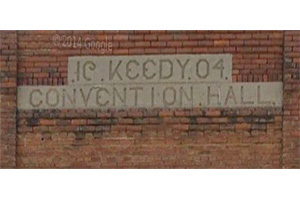
 |
 |
|||||||||||||||||||||||||||||||||||||||||||||||||||||||||||||||
Okay, it’s not a small town. But this feature cannot spend all of its time lamenting the shuttered stores of indistinguishable Texas hamlets. It could, but variety, spice, etc. This short stretch of Newark fascinates me. You can read the old boom, the sullen trough (when nothing new was built), the depressed years of the 60s when they barely had the resources to take down old stuff or ruin Jazz Age facades. Look at this! That’s almost a 100-year-old view, right there behind the detritus.
It’s been closed since 1986, its 100th anniversary. Hold on, you say, that’s not an 1886 design. Correct! Thomas Lamb remodeled it in 1917. Well, he had help.
There are plans to bring it back. In the meantime, some great pics of the trashed interior here.
The building has been rescued, but there’s an old drunk on the roof still yelling at people:
It’s been a long time since anyone put up a permanent billboard for a tavern. And don’t you know that was a lively place.
Top to bottom, the story of Newark:
1871 - 1929. Not a propitious set of numbers. It’s like markings on a tombstone.
2012: Bernard’s Shoe Repair, a sign that must have been a half century old, was still there.
And now it’s not. The Buckaroo’d Chicken Shack survives, though.
2012 Mannings, whatever that was, had a vertical sign, one of the things that gives a street visual pique.
Alas.
2012: The street has that Led Zep Physical Graffiti vibe.
But now:
On the way up, in other words.
Finally:
No one will ever wonder about this building. What went on inside. Who designed it. Whose name might have been carved on the cornice. What stores and offices came and went. We all know it’s either an office building for a big company or bank, or a government center. And there all the mystery ends. ADDENDUM I would've been content to leave the entry as it was, but I went back to check something and discovered a building that just . . . astonishes me. Hardly news to Newarkians, but for those of us soaring over the city on Google Earth like bored crows, it's a remarkable revelation.
WHAT THE HELL IS THAT THING Let's take a look at the tall tower faced with terra-cotta. I've photoshopped the street view to look straight on:
That's an impressive overhang, and you might think: theater?
Has to be. But look again at the complex:
It looks like the thin structure's top floor is just a lobby that leads to the main theater, which is up on the top floor. If not a theater, then an auditorium of some sort. But there's more!
It goes all the way around the block. It all looks connected.
And it's crumbling.
No one at the time figured this was the future.
What was this extraordinary building? Who lofted the movie palace into the clouds? Frederick Proctor, that's who. Cinema Treasures:
A derilect since 1968. Much more here.
|
||||||||||||||||||||||||||||||||||||||||||||||||||||||||||||||||
 |
 This one, if you don't know Newark, has something incredible.
This one, if you don't know Newark, has something incredible. 





































